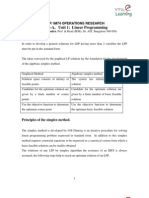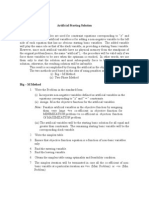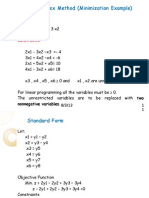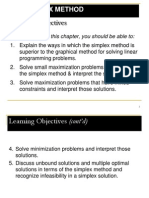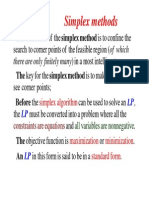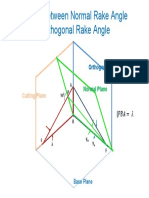04 Simplex 2
04 Simplex 2
Uploaded by
Potnuru VinayCopyright:
Available Formats
04 Simplex 2
04 Simplex 2
Uploaded by
Potnuru VinayOriginal Description:
Copyright
Available Formats
Share this document
Did you find this document useful?
Is this content inappropriate?
Copyright:
Available Formats
04 Simplex 2
04 Simplex 2
Uploaded by
Potnuru VinayCopyright:
Available Formats
The Simplex algorithm
Abstract: In this lecture we discuss the
computational aspects of the Simplex
algorithm. We shall see how a LPP is put
into a simplex tableau. Starting from a BFS,
we explain how to proceed step by step till
we reach the optimal solution. The
Mathematics behind the method (algorithm)
will be seen only later. We illustrate the
Simplex method by examples.
Example Consider the LPP
Maximize
2 1
9 8 x x z + =
Subject to the constraints
0 ,
70 3 3
80 6 2
50 3 2
2 1
2 1
2 1
2 1
>
s +
s +
s +
x x
x x
x x
x x
Introducing slack variables, the LPP is
same as
Maximize
subject to the constraints
0 , , , ,
70 3 3
80 6 2
50 3 2
3 2 1 2 1
3 2 1
2 2 1
1 2 1
>
= + +
= + +
= + +
s s s x x
s x x
s x x
s x x
(*)
1 2 1 2 3
8 9 0 0 0 z x x s s s = + + + +
We see that if we take x
1
, x
2
as nonbasic
variables, a BFS can be got immediately as
(0,0, 50,80,70). Remember the first two
components refer to x
1
, x
2
and the last three
components refer to s
1
, s
2
, s
3
.
This is possible because in the LHS of the
constraint equations (*) the coefficients of
the basic variables s
1
, s
2
, s
3
form an Identity
matrix (of size 3 x 3).
This is the first thing to be had to start
the simplex method: the coefficients of
the starting basic variables in the
constraint equations form an identity
matrix so that we can read out the
starting BFS. Next we put the objective
function and the constraint equations in
a table (usually referred to as a Simplex
tableau). For this we write the objective
function also as an equation:
1 2 1 2 3
8 9 0 0 0 0 z x x s s s + + + =
Simplex tableau (Starting tableau)
Basic z x
1
x
2
s
1
s
2
s
3
Solution
z 1 -8 -9 0 0 0 0
s
1
0 2 3 1 0 0 50
s
2
0 2 6 0 1 0 80
s
3
0 3 3 0 0 1 70
We note that the z-row is the objective
function row. The remaining 3 rows are the
basic variable rows. Each row corresponds
to a basic variable; the leftmost variable
denotes the basic variable corresponding to
that row. Except for the legends (the
topmost row and the leftmost column), all
the other 4 rows are the objective function
row and the constraint equations. Notice
that in the objective function row,
the coefficients of the basic variables are
zero. This is the second requirement to start
the simplex algorithm. Also we note that in
each column corresponding to a basic
variable, only that basic variable has a non-
zero coefficient, namely 1, and all the other
basic variables have zero coefficients.
We see at present, the objective function, z,
has value zero. We now seek to make one of
the nonbasic variables as basic (and so) one
of the basic variables will become nonbasic
(that is will drop down to zero) and the
nonbasic variable that will become basic is
chosen such that the objective function will
improve: i.e. in a maximization problem it
will increase and in a minimization problem
it will decrease. The nonbasic variable that
will become basic is referred to as entering
variable and the basic variable that will
become nonbasic is referred to as leaving
variable.
Choose that variable as the entering variable
which has
Criterion for entering variable:
(Optimality Condition)
the most ve coefficient in the z-row in
case it is a maximization problem
(as the variable which has the most +ve
coefficient in the z-row in case it is a
minimization problem).
(Break the ties arbitrarily.)
Criterion for leaving variable (Feasibilty
Condition)
>0 :
ij
ij
i
a
a
b
is least.
Let b
i
be the RHS of the ith row. Let a
ij
be
the coefficient of the entering variable x
j
in
the ith row. The following minimum ratio
test decides the leaving variable:
Choose x
k
as the leaving variable where k is
given as that row index i for which the ratio
(Break the ties arbitrarily.)
The entering variable column is called the
pivot column. The leaving variable row is
called the pivot row. The coefficient in the
intersection of the two is referred to as the
pivot element. Now we apply elementary row
operations to modify the simplex tableau so
that the pivot column has 1 at the pivot
element and zero in all other places.
We say one iteration is over and the new
basic feasible solution and the new objective
function value can be read from the new
tableau. We illustrate by an example.
The elementary Row operations are as
follows:
+ We shall also change the legend of the new
pivot row only as the entering variable.
+ New pivot row = old pivot row pivot element
+ New z row = old z row (coefficient of the
entering variable in old z row * New pivot
row)
+ Any other new row = corresponding old row
(old coefficient of the entering variable in
that row * New pivot row)
Simplex tableau (Starting tableau)
Basic z x
1
x
2
s
1
s
2
s
3
Solution
z 1 -8 -9 0 0 0 0
s
1
0 2 3 1 0 0 50
s
2
0 2 6 0 1 0 80
s
3
0 3 3 0 0 1 70
+Enters
Leaves
Pivot element
Performing the elementary Row operations,
we get the new Simplex tableau below
Basic z x
1
x
2
s
1
s
2
s
3
Solution
z 1 -5 0 0 3/2 0 120
s
1
0 1 0 1 -1/2 0 10
x
2
0 1/3 1 0 1/6 0 40/3
s
3
0 2 0 0 -1/2 1 30
+ Enters
Leaves
Pivot element
Performing the elementary Row operations,
we get the new Simplex tableau below
Basic z x
1
x
2
s
1
s
2
s
3
Solution
z 1 0 0 5 -1 0 170
x
1
0 1 0 1 -1/2 0 10
x
2
0 0 1 -1/3 1/3 0 10
s
3
0 0 0 -2 1/2 1 10
+ Enters
Leaves
Pivot element
Performing the elementary Row operations,
we get the new Simplex tableau below.
Basic z x
1
x
2
s
1
s
2
s
3
Solution
z 1 0 0 5 0 0 190
x
1
0 1 0 -1 0 0 20
x
2
0 0 1 1 0 0 10/3
s
2
0 0 0 -4 1 2 20
This is optimal as all entries in z row are > 0.
Optimum value = 190 at x
1
=20, x
2
=10/3
(0,40/3)
(10,10)
(70/3,0)
(20,10/3)
Optimal at
Graphical Solution of the problem
(0,0)
Direction of
increasing z
Problem 2(a) Problem set 3.3B Page 89
Maximize
Subject to the constraints
0 , , ,
10 2 4
8 2 2
40 4 2 2
4 3 2 1
4 3 2 1
4 3 2 1
4 3 2 1
>
s +
s + +
s + +
x x x x
x x x x
x x x x
x x x x
Example Consider the LPP
1 2 3 4
2 3 5 z x x x x = + +
Introducing slack variables, the LPP becomes
Maximize
Subject to the constraints
0 , , , , , ,
10 2 4
8 2 2
40 4 2 2
3 2 1 4 3 2 1
3 4 3 2 1
2 4 3 2 1
1 4 3 2 1
>
= + +
= + + +
= + + +
s s s x x x x
s x x x x
s x x x x
s x x x x
1 2 3 4 1 2 3
2 3 5 0 0 0 z x x x x s s s = + + + + +
Basic z x1 x2 x3 x4 s1 s2 s3 Sol.
z 1 -2 -1 3 -5 0 0 0 0
s1 0 1 2 -2 4 1 0 0 40
s2 0 2 -1 1 2 0 1 0 8
s3 0 4 -2 1 -1 0 0 1 10
2
x4 0 1 -1/2 1/2 1 0 1/2 0 4
z 1 3 -7/2 11/2 0 0 5/2 0 20
s1 0 -3 4 -4 0 1 -2 0 24
s3 0 5 -5/2 3/2 0 0 1/2 1 14
4
x2 0 -3/4 1 -1 0 1/4 -1/2 0 6
z 1 3/8 0 2 0 7/8 3/4 0 41
x4 0 5/8 0 0 1 1/8 1/4 0 7
s3 0 25/8 0 -1 0 5/8 -3/4 1 29
The last tableau is the optimal tableau as all
entries in the objective function row are 0
and the LPP is a maximization problem.
Optimal Solution is
x
1
= 0, x
2
= 6, x
3
= 0, x
4
= 7
And the Optimal z (= Maximum z)
= 41
Solve the following LPP:
Maximize
3 2 1
4 2 x x x z + + =
Subject to the constraints
0 , ,
7 2 2
8 4
10 5 3
3 2 1
3 1
3 2 1
3 2 1
>
s +
s + +
s + +
x x x
x x
x x x
x x x
Introducing slack variables, the LPP becomes
Maximize
Subject to the constraints
1 2 3 1
1 2 3 2
1 3 3
1 2 3 1 2 3
3 5 10
4 8
2 2 7
, , , , , 0
x x x s
x x x s
x x s
x x x s s s
+ + + =
+ + + =
+ + =
>
1 2 3 1 2 3
2 4 0 0 0 z x x x s s s = + + + + +
Basic z x1 x2 x3 s1 s2 s3 Sol.
z 1 -1 -2 -4 0 0 0 0
s1 0 3 1 5 1 0 0 10
s2 0 1 4 1 0 1 0 8
s3 0 2 0 2 0 0 1 7
s2 0 2/5 19/5 0 -1/5 1 0 6
z 1 7/5 -6/5 0 4/5 0 0 8
x3 0 3/5 1/5 1 1/5 0 0 2
s3 0 4/5 -2/5 0 -2/5 0 1 3
x3 0 11/19 0 1 4/19 -1/19 0 32/19
z 1 29/19 0 0 14/19 6/19 0 188/19
x2 0 2/19 1 0 -1/19 5/19 0 30/19
s3 0 16/19 0 0 -8/19 2/19 1 69/19
The last tableau is the optimal tableau as all
entries in the objective function row are 0
and the LPP is a maximization problem.
Optimal Solution is
x
1
= 0, x
2
= 30/19, x
3
= 32/19
And the Optimal z (= Maximum z)
= 188/19
Exceptional cases Identified from the
Simplex tableau
* Tie for leaving variable - Degeneracy
If in a Simplex iteration, there is a tie for
leaving variable, then the resulting BFS will
be degenerate, in the sense that one of the
basic variables will also be zero. This may
result in getting a new BFS without
improving z. And in some cases this may
lead to cycling.
* Multiple (Alternative) Optimal Solutions
Suppose in the optimal tableau, some
nonbasic variable has zero coefficient in the
objective function row. Then that variable
can become basic and we would get another
BFS. Since the coefficient of the entering
variable in the objective function row. The
objective function does not improve. Hence
the new BFS we get is an alternative
Optimal Solution. Usually you are
supposed to give all Optimal Solutions.
* No leaving variable unbounded Solution
Suppose in a Simplex iteration, some
variable can enter but no variable can leave.
This will happen when all the entries in the
entering variable column are either zero or
negative, This means the entering variable
(which is right now having the zero value)
can be increased indefinitely without
violating any of the constraints and thus z
can be increased indefinitely or the problem
has unbounded solution.
Problem 5 Problem Set 2.5A Page 61
Shale Oil, located on the island of Aruba, has a
capacity of 600,000 barrels of crude oil per day.
The final products from the refinery include two
types of unleaded gasoline: regular and premium.
The refining process encompasses three stages: (1)
a distillation tower that produces feedstock, (2) a
cracker unit that produces gasoline stock by using
a portion of the feedstock produced from the
distillation tower, and (3) a blender unit that
blends the gasoline stock from the cracker unit and
the feedstock from the distillation tower. Both
Both regular and premium gasoline can be
blended from either the the feedstock or the
gasoline stock at different production costs. The
company estimates that the net profit per barrel of
regular gasoline is $7.70 and $5.20, depending on
whether it is blended from feedstock or from
gasoline stock. The corresponding profit values
for the premium grade are $10.40 and $12.30.
Design specifications require 5 barrels of crude oil
to produce 1 barrel of feedstock. The capacity of the
cracker unit is 40,000 barrels of feedstock a day. All
remaining feedstock is directly used in the blender
unit to produce end-product gasoline. The demand
The demand limits for regular and premium
gasoline are 80,000 and 50,000 barrels per day.
Develop a model for determining the optimum
production schedule for the refinery.
Distillation
Tower
Cracker
Unit
Blender Unit
Let x
1
units from feedstock be used to blend
(=make) regular gasoline
Let x
2
units from feedstock be used to blend
(=make) premium gasoline
Let x
3
units from gasoline stock be used to
blend (=make) regular gasoline
Let x
4
units from gasoline stock be used to
blend (=make) premium gasoline
Thus we have to maximize the profit
1 2 3 4
7.70 10.40 5.20 12.30 z x x x x = + + +
Subject to the constraints
1 2 3 4
120, 000 x x x x + + + s
3 4
40, 000 x x + s
1 3
80, 000 x x + s
2 4
50, 000 x x + s
1 2 3 4
, , , 0 x x x x >
Optimum Solution
1
2
3
4
70, 000
10, 000
0
40, 000
x
x
x
x
=
=
=
=
Maximum z = 1135000
You might also like
- TP1-W2-S3 YudhaDocument7 pagesTP1-W2-S3 YudhaKho Via0% (1)
- Simplex Method ExamplesDocument21 pagesSimplex Method ExamplesAnonymous HEzOOydNo ratings yet
- Big M MethodDocument12 pagesBig M MethodAbhishek SinghNo ratings yet
- Problem 5 Problem Set 3.4B Pages 101-102 Maximize Subject To The ConstraintsDocument30 pagesProblem 5 Problem Set 3.4B Pages 101-102 Maximize Subject To The ConstraintsPotnuru VinayNo ratings yet
- L09 - Some Exceptional Cases in LPPs PDFDocument30 pagesL09 - Some Exceptional Cases in LPPs PDFNirmitNo ratings yet
- Dual Simplex Method For Solving The PrimalDocument49 pagesDual Simplex Method For Solving The PrimalMyth SoumithNo ratings yet
- Addition of A New ConstraintDocument22 pagesAddition of A New ConstraintPotnuru VinayNo ratings yet
- m140 Chapter3 Sec3.4 F18completedDocument6 pagesm140 Chapter3 Sec3.4 F18completedHasmitthaNo ratings yet
- Dual Simplex Method For Solving The PrimalDocument49 pagesDual Simplex Method For Solving The PrimalPotnuru VinayNo ratings yet
- 08 Simplex 3 CDocument31 pages08 Simplex 3 CPotnuru VinayNo ratings yet
- Class Note Simplex MethodDocument6 pagesClass Note Simplex MethodBijay NagNo ratings yet
- Simplex Method CalculatorDocument6 pagesSimplex Method Calculatoribrahim aboalazmNo ratings yet
- Simplex MethodDocument6 pagesSimplex MethodKen SendaydiegoNo ratings yet
- Unit 2 Lecturer Notes of Linear Programming of or by DRDocument46 pagesUnit 2 Lecturer Notes of Linear Programming of or by DRSharath ChandraNo ratings yet
- Artifical Variable or Chap 3Document27 pagesArtifical Variable or Chap 3Monisha NarayanNo ratings yet
- CJ - ZJ Method SimplexDocument7 pagesCJ - ZJ Method SimplexChandra SekharNo ratings yet
- Simplex Method (Minimization Example) : Object FunctionDocument6 pagesSimplex Method (Minimization Example) : Object FunctionDarya MemonNo ratings yet
- Ca2 orDocument9 pagesCa2 orShreyasri GhoshalNo ratings yet
- Lecture Note 1 CE605A&CHE705BDocument5 pagesLecture Note 1 CE605A&CHE705BSamrat RouthNo ratings yet
- Big M MethodDocument28 pagesBig M Methodأزرين رحيم0% (1)
- Course Code and Title: Lesson Number: Topic:: Solve LP Problems Using Simplex Maximization MethodDocument10 pagesCourse Code and Title: Lesson Number: Topic:: Solve LP Problems Using Simplex Maximization MethodJessaNo ratings yet
- Simplex MethodDocument61 pagesSimplex MethodvasudhasinghNo ratings yet
- Simplex Method ComputationDocument7 pagesSimplex Method ComputationGoody keyzNo ratings yet
- Modular Arithmetic and The RSA CryptosystemDocument92 pagesModular Arithmetic and The RSA CryptosystemWa Ode MuslimahNo ratings yet
- CH 03 Simplex Method and Sensitivity AnalysisDocument121 pagesCH 03 Simplex Method and Sensitivity AnalysisAura fairuzNo ratings yet
- Non-Normal Linear Programming Problem: in Case of Maximization ProblemDocument5 pagesNon-Normal Linear Programming Problem: in Case of Maximization ProblemTóth PéterNo ratings yet
- The Simplex Method.1Document40 pagesThe Simplex Method.1wajdxothmanNo ratings yet
- In This Presentation We Illustrate The Ideas Developed in The Previous Presentation With Two More ProblemsDocument21 pagesIn This Presentation We Illustrate The Ideas Developed in The Previous Presentation With Two More ProblemsPotnuru VinayNo ratings yet
- 9 Chapter 4 Simplex MethodDocument19 pages9 Chapter 4 Simplex Methodtanmoy biswasNo ratings yet
- The Two-Phase Simplex Method: Case 1Document10 pagesThe Two-Phase Simplex Method: Case 1AditiNo ratings yet
- Opt lp3Document32 pagesOpt lp3no3johnnyNo ratings yet
- Simplex MethodDocument8 pagesSimplex MethodalcofieNo ratings yet
- Lec 5Document25 pagesLec 5Gunaseelan RvNo ratings yet
- LPP TotalDocument33 pagesLPP TotalJatin ThakkarNo ratings yet
- In This Presentation We Illustrate The Ideas Developed in The Previous Presentation With Two More ProblemsDocument21 pagesIn This Presentation We Illustrate The Ideas Developed in The Previous Presentation With Two More ProblemsAngad SehdevNo ratings yet
- Exam 1 SolnDocument6 pagesExam 1 SolnMazin AlahmadiNo ratings yet
- Chapter 3 LP Simplex MethodDocument36 pagesChapter 3 LP Simplex MethodJazz Kaur50% (4)
- MATH39011 Mathematical Programming I SOLUTIONS To Examples 2Document4 pagesMATH39011 Mathematical Programming I SOLUTIONS To Examples 2Ng Chun HiuNo ratings yet
- Simplex AlgorithmDocument26 pagesSimplex AlgorithmKamal GaneriwalaNo ratings yet
- Simplex Method: Minimization Two Phase MethodDocument27 pagesSimplex Method: Minimization Two Phase Methodmelbe5jane5quiamcoNo ratings yet
- Lecture 5Document21 pagesLecture 5AhmedNo ratings yet
- Big-M Two Phase MethodsDocument51 pagesBig-M Two Phase Methodsbits_who_am_iNo ratings yet
- Unit 2 of Linear Programming of OR PDFDocument46 pagesUnit 2 of Linear Programming of OR PDFAnusha KulalNo ratings yet
- Ioi T1trabajotipoDocument10 pagesIoi T1trabajotipoIngrid MartínezNo ratings yet
- Heizer10e Tut3Document10 pagesHeizer10e Tut3Ralf SanderNo ratings yet
- Solutions of Linear Programming ModelDocument9 pagesSolutions of Linear Programming Modelعباس محمد عباس عبدالحسينNo ratings yet
- Simplex ProcedureDocument4 pagesSimplex ProcedureRajesh NakotiNo ratings yet
- Artificial Variable Techniques - Big M-MethodDocument26 pagesArtificial Variable Techniques - Big M-MethodPotnuru VinayNo ratings yet
- Duality in LPPDocument8 pagesDuality in LPPTibelchNo ratings yet
- Additional Simplex Algorithms: Dual Simplex Method and Generalized Simplex MethodDocument44 pagesAdditional Simplex Algorithms: Dual Simplex Method and Generalized Simplex MethodAnimesh ChoudharyNo ratings yet
- Advance Operations ResearchDocument255 pagesAdvance Operations Researchgoldy243usNo ratings yet
- Optimization Lecture 2Document36 pagesOptimization Lecture 2Katie CookNo ratings yet
- A Brief Introduction to MATLAB: Taken From the Book "MATLAB for Beginners: A Gentle Approach"From EverandA Brief Introduction to MATLAB: Taken From the Book "MATLAB for Beginners: A Gentle Approach"Rating: 2.5 out of 5 stars2.5/5 (2)
- Student Solutions Manual to Accompany Economic Dynamics in Discrete Time, second editionFrom EverandStudent Solutions Manual to Accompany Economic Dynamics in Discrete Time, second editionRating: 4.5 out of 5 stars4.5/5 (2)
- Mathematics 1St First Order Linear Differential Equations 2Nd Second Order Linear Differential Equations Laplace Fourier Bessel MathematicsFrom EverandMathematics 1St First Order Linear Differential Equations 2Nd Second Order Linear Differential Equations Laplace Fourier Bessel MathematicsNo ratings yet
- MATLAB for Beginners: A Gentle Approach - Revised EditionFrom EverandMATLAB for Beginners: A Gentle Approach - Revised EditionRating: 3.5 out of 5 stars3.5/5 (11)
- Matrices with MATLAB (Taken from "MATLAB for Beginners: A Gentle Approach")From EverandMatrices with MATLAB (Taken from "MATLAB for Beginners: A Gentle Approach")Rating: 3 out of 5 stars3/5 (4)
- Student's Solutions Manual and Supplementary Materials for Econometric Analysis of Cross Section and Panel Data, second editionFrom EverandStudent's Solutions Manual and Supplementary Materials for Econometric Analysis of Cross Section and Panel Data, second editionNo ratings yet
- 26 PertDocument25 pages26 PertPotnuru VinayNo ratings yet
- Hillier and Lieberman Problem 14.4-2 Page 746Document27 pagesHillier and Lieberman Problem 14.4-2 Page 746Potnuru VinayNo ratings yet
- The Transportation Model - FormulationsDocument26 pagesThe Transportation Model - FormulationsPotnuru VinayNo ratings yet
- Iterative Computations of The Transportation AlgorithmDocument35 pagesIterative Computations of The Transportation AlgorithmPotnuru VinayNo ratings yet
- Game Theory: Strategies Selected by The AdversariesDocument54 pagesGame Theory: Strategies Selected by The AdversariesPotnuru VinayNo ratings yet
- Explanation of The Entries in Any Simplex Tableau in Terms of The Entries of The Starting TableauDocument33 pagesExplanation of The Entries in Any Simplex Tableau in Terms of The Entries of The Starting TableauPotnuru VinayNo ratings yet
- 18 Sensi 1Document24 pages18 Sensi 1Potnuru VinayNo ratings yet
- Duality Theorems Finding The Dual Optimal Solution From The Primal Optimal TableauDocument25 pagesDuality Theorems Finding The Dual Optimal Solution From The Primal Optimal TableauPotnuru VinayNo ratings yet
- Determination of Starting Basic Feasible SolutionDocument12 pagesDetermination of Starting Basic Feasible SolutionPotnuru VinayNo ratings yet
- Some Problems Illustrating The Principles of DualityDocument22 pagesSome Problems Illustrating The Principles of DualityPotnuru VinayNo ratings yet
- Dual Simplex Method For Solving The PrimalDocument49 pagesDual Simplex Method For Solving The PrimalPotnuru VinayNo ratings yet
- 08 Simplex 3 CDocument31 pages08 Simplex 3 CPotnuru VinayNo ratings yet
- In This Presentation We Illustrate The Ideas Developed in The Previous Presentation With Two More ProblemsDocument21 pagesIn This Presentation We Illustrate The Ideas Developed in The Previous Presentation With Two More ProblemsPotnuru VinayNo ratings yet
- X X X X: Minimize Subject To The ConstraintsDocument15 pagesX X X X: Minimize Subject To The ConstraintsPotnuru VinayNo ratings yet
- Matrix Formulation of The LppsDocument13 pagesMatrix Formulation of The LppsPotnuru VinayNo ratings yet
- Minimize Subject To The Constraints: X X X XDocument16 pagesMinimize Subject To The Constraints: X X X XPotnuru VinayNo ratings yet
- 2-D Static Truss: Step 9: Validate The ResultsDocument2 pages2-D Static Truss: Step 9: Validate The ResultsPotnuru VinayNo ratings yet
- 01 Formulation of LPPsDocument36 pages01 Formulation of LPPsMeghashyam SandeepNo ratings yet
- Problem Set 2Document2 pagesProblem Set 2Potnuru VinayNo ratings yet
- Final Project Report: F.O.B.O Floppy Box Robot An Experiment A.I and Machine LearningDocument44 pagesFinal Project Report: F.O.B.O Floppy Box Robot An Experiment A.I and Machine LearningPotnuru VinayNo ratings yet
- Artificial Variable Techniques - Big M-MethodDocument26 pagesArtificial Variable Techniques - Big M-MethodPotnuru VinayNo ratings yet
- 2-D Static Truss: Author: E-Mail: Rb88@cornell - EduDocument2 pages2-D Static Truss: Author: E-Mail: Rb88@cornell - EduPotnuru VinayNo ratings yet
- Normal Rake AngleDocument1 pageNormal Rake AnglePotnuru VinayNo ratings yet













